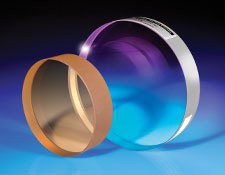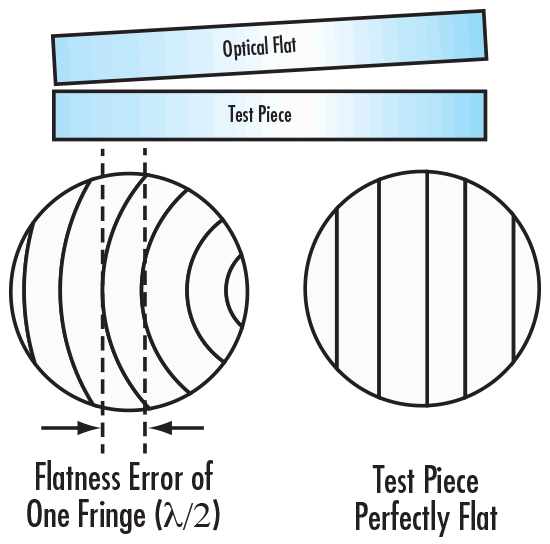オプティカルフラット
精密オプティカルフラット

オプティカルフラットは、精密に研磨された平坦な面で、未知な面の平面度を比較する際の基準面として用いられます。エドモンド・オプティクスは、片面と両面オプティカルフラットの両方を、ZERODUR®か合成石英基板で提供しています。オプティカルフラットの平面度は、基準波長の632.8nmに対する分数で測定されています。λ/20 フラットの場合、PV偏差が最大で632.8/20、すなわち31.64nmになります。当社は、片面オプティカルフラットをλ/4、λ/10、およびλ/20のいくつかのレベルの平面度で提供しています。両面オプティカルフラットも、λ/4、λ/10、およびλ/20の平面度でラインナップします。
オプティカルフラットで何が見える?
オプティカルフラットの研磨面を測定対象面に接触した状態で重ねると、単色光で観察した時に暗い縞と明るい縞が現れます。これらの縞は干渉縞として知られ、その形状で測定対象面の平面度が視覚的に再現されます。平面度は、干渉縞の曲がり量と縞の間隔によって示されます。干渉縞がまっすぐかつ平行、また等間隔であれば、測定対象面の平面度は基準面のそれと同じか、あるいはそれ以上の平面度であることを意味しています。
アプリケーション
研磨された面の平面度の測定は、測定面とオプティカルフラット面間の変化の比較によって視覚的に行われます。オプティカルフラットは、ゲージブロックの摩耗と精度の検査や、 ウインドウ、プリズム、フィルター、ミラー等のさまざまな部品のテストなど、多くのアプリケーションに用いられる汎用光学部品です。また、要求の厳しい干渉実験での極めて平坦な光学窓としても使われます。
オプティカルフラットの仕組み

Figure 1: オプティカルフラットの仕組み
オプティカルフラットは、光の干渉の特性を利用して所望の面の平面度を視覚化します。 「テストプレート」とも呼ばれるオプティカルフラットを測定対象面に重ねると、くさび形の空気層が形成されます。フラット面と測定対象面間での接触していないエリアによって、そのくさび形空気層が形成されます。くさび形空気層の厚さの変化によって、干渉縞の形状と向きが決まります。干渉縞によって現わされるその曲がり量は、測定面の平面度を決定するのに用いられます。くさび形空気層が大きすぎる場合、間隔の狭い縞が数多く現れますので、形成されたパターンを分析するのが難しくなります。この場合、オプティカルフラットの上部に軽く圧力をかけるだけでその問題を軽減できます。
面の特定領域の平面度の決定は、二本の平行な仮想線を描くことによって行われます。一本を一つの縞の両端間に、残りの一本をその同じ縞の頂点上に置きます。その線間にある縞の数を見ることで平面度を決定することができます。単色光は、観察する際にコントラストを鮮明にするのに用いられ、平面度は単一波長の関数として表されます。
どの平面度のフラットを用いるべきか - λ/4, λ/10, λ/20
これはよくある質問ですが、測定対象面によって答えが異なります。測定面がλ/4より平坦であれば、干渉パターンの変化を表すためにはより精密な平面度のフラットが必要になります。この場合、λ/4フラットだとまっすぐな平行線しか現れませんが、λ/10かλ/20フラットだと測定面を正確に測定するのに十分な曲線が得られるかもしれません。
どの材料を用いるべきか? - 合成石英 or ZERODUR®
合成石英:当社では、0.55x10-6/℃の非常に低い熱膨張係数を有する無色透明な合成石英を使っています。耐久性が高く、耐摩耗性にも優れるため、頻繁に用いるアプリケーションには合成石英が良好な選択肢になります。機械的、熱的、電気的、および化学的な特性は、硝材のデータシート (光学ガラスメーカーのウェブサイトからダウンロード可能) から見つけることができます。
ZERODUR®:黄色味がかったZERODUR®は、Schott Research Labs社が開発した透明なガラスセラミックです。ZERODUR®は、±0.10x10-6/℃の極めて低い熱膨張係数を有します。温度変動が懸念されるアプリケーションでは、ZERODUR®は比類のない熱安定性を提供します。機械的、熱的、電気的、および化学的な機械的、熱的、電気的、および化学的な特性は、硝材のデータシート (光学ガラスメーカーのウェブサイトからダウンロード可能) から見つけることができます。
自社内干渉試験
全てのオプティカルフラットと精密グレードの平面ミラーは、当社のZygo GPI-XP干渉計を用いて平面度を測定しています。エドモンド・オプティクスは、干渉計やその他の精密試験機器を用いて、最高品質の光学部品を提供・確保することができます。
再校正
当社のオプティカルラボでは、直径4" (101.6mm) までの当社製オプティカルフラットを有料で再認証できます。再認証できるのは、当社から購入したフラットのみです。オプティカルフラット再認証の詳細は、当社営業部にご連絡ください。













もしくは 現地オフィス一覧をご覧ください
クイック見積りツール
商品コードを入力して開始しましょう
Copyright 2023, エドモンド・オプティクス・ジャパン株式会社
[東京オフィス] 〒113-0021 東京都文京区本駒込2-29-24 パシフィックスクエア千石 4F
[秋田工場] 〒012-0801 秋田県湯沢市岩崎字壇ノ上3番地